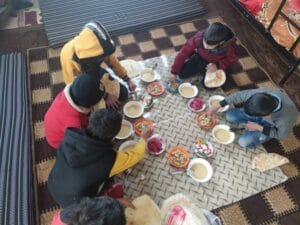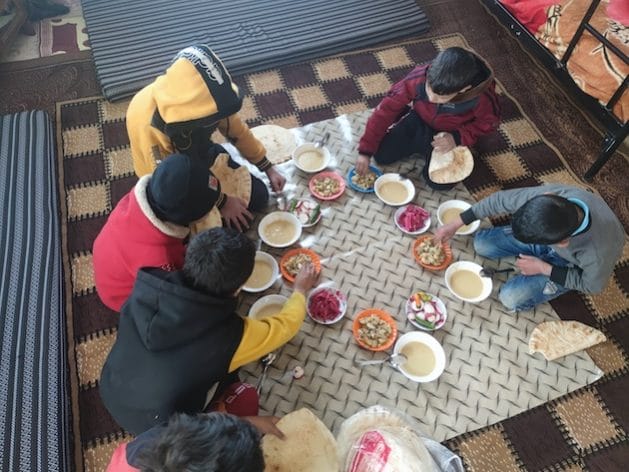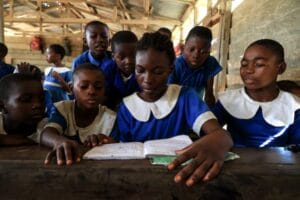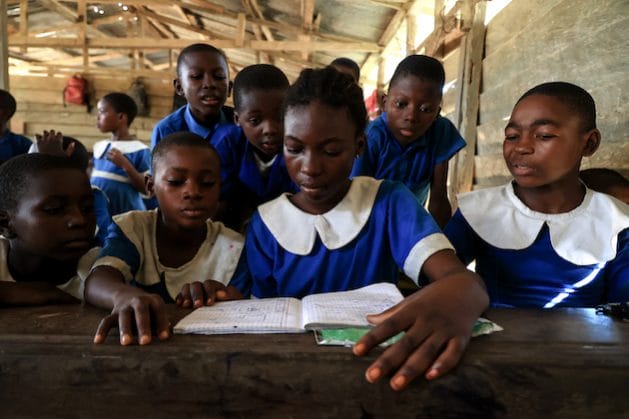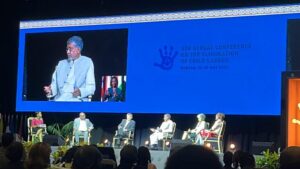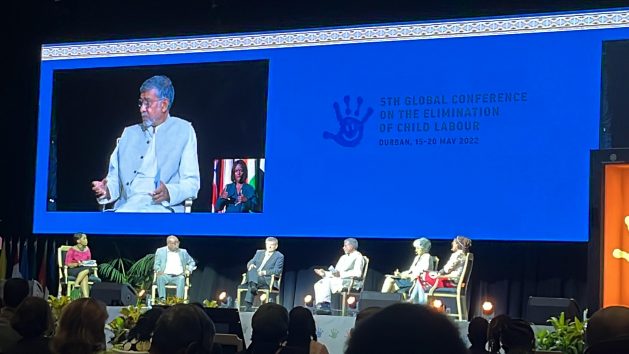
Africa, Armed Conflicts, Biodiversity, Child Labour, Climate Change Finance, Climate Change Justice, Combating Desertification and Drought, Conferences, Development & Aid, Disaster Management, Editors’ Choice, Energy, Environment, Europe, Featured, Food and Agriculture, Gender Violence, Global, Headlines, Human Rights, Migration & Refugees, Peace, Sustainable Development Goals, TerraViva United Nations, Water & Sanitation, Women & Climate Change, Youth
Combating Desertification and Drought

In Nairobi’s Kibera, the largest urban informal settlement in Africa, girls and women wait their turn for the scarce water supply. Credit: Manipadma Jena/IPS
– While droughts creep in stealthily, their impacts are often more devastating and far-reaching than any other disaster. Inter-community conflict, extremist violence, and violence and injustice against vulnerable girls and women happen at the intersection of climate-induced droughts and drought-impoverished communities.
Five consecutive years of failed rain in Ethiopia, Somalia, and Kenya brought the worst drought in seventy years to the Horn of Africa by 2023. In Somalia, the government estimated 43,000 excess deaths in 2022 alone due to drought-linked hunger.
As of early current year, 4.4 million people, or a quarter of Somalia’s population, face crisis-level food insecurity, including 784,000 people expected to reach emergency levels. Together, over 90 million people across Eastern and Southern Africa face acute hunger. Some areas have been enduring their worst ever recorded drought, finds a United Nations-backed study, Drought Hotspots Around the World 2023-2025 released today at the 4th International Conference on Financing for Development (FfD4).

UNCCD Executive Secretary Ibrahim Thiaw noted that while drought is here and escalating, it demands urgent global cooperation. Photo courtesy: UNCCD
High temperatures and a lack of precipitation in 2023 and 2024 resulted in water supply shortages, low food supplies, and power rationing. In parts of Africa, tens of millions faced drought-induced food shortages, malnutrition, and displacement, finds the new 2025 drought analysis, Drought Hotspots Around the World 2023-2025, by the UN Convention to Combat Desertification (UNCCD) and the U.S. National Drought Mitigation Center (NDMC).
It not just comprehensively synthesizes impacts on humans but also on biodiversity and wildlife within the most acute drought hotspots in Africa (Somalia, Ethiopia, Zimbabwe, Zambia, Malawi, Botswana, and Namibia), the Mediterranean (Spain, Morocco, and Türkiye), Latin America (Panama and the Amazon Basin) and Southeast Asia.
Desperate to Cope but Pulled Into a Spiral of Violence and Conflict
“The coping mechanisms we saw during this drought grew increasingly desperate,” says lead author Paula Guastello, NDMC drought impacts researcher. “Girls pulled from school and forced into marriage, hospitals going dark, and families digging holes in dry riverbeds just to find contaminated water. These are signs of severe crisis.”
Over one million Somalis in 2022 were forced to move in search of food, water for families and cattle, and alternative livelihoods. Migration is a major coping mechanism mostly for subsistence farmers and pastoralists. However, mass migration strains resources in host areas, often leading to conflict. Of this large number of displaced Somalis, many crossed into territory held by Islamic extremists.
Drought in a Sub-Saharan district leads to 8.1 percent lower economic activity and 29.0 percent higher extremist violence, an earlier study found. Districts with more months of drought in a given year and more years in a row with drought experienced more severe violence.
Drought expert and editor of the UNCCD study Daniel Tsegai told IPS at the online pre-release press briefing from the Saville conference that drought can turn into an extremist violence multiplier in regions and among communities rendered vulnerable by multi-year drought.
Climate change-driven drought does not directly cause extremist conflict or civil wars; it overlaps and exacerbates existing social and economic tensions, contributing to the conditions that lead to conflict and potentially influencing the rise of extremist violence, added Tsegai.

Extracting water from a traditional well using a manual pulley system. Credit: Abdallah Khalili / UNCCD
Though the effects of climate change on conflict are indirect, they have been seen to be quite severe and far-reaching. An example is the 2006-2011 drought in Syria, seen as the worst in 900 years. It led to crop failures, livestock deaths and mass rural displacement into cities, creating social and political stress. Economic disparities and authoritarian repression gave rise to extremist groups that exploited individuals facing unbearable hardships.
The UN study cites entire school districts in Zimbabwe that saw mass dropouts due to hunger and school costs. Rural families were no longer able to afford uniforms and tuition, which cost USD 25. Some children left school to migrate with family and work.
Drought-related hunger impact on children
Hungry and clueless about their dark futures, children become prime targets for extremists’ recruitment.
A further example of exploitation of vulnerable communities by extremists is cited in the UNCCD drought study. The UN World Food Programme in May 2023 estimated that over 213,000 more Somalis were at “imminent risk” of dying of starvation. Little aid had reached Somalia, as multiple crises across the globe spread resources thin.
However, al-Shabab, an Islamic extremist group tied to al-Qaida, allegedly prevented aid from reaching the parts of Somalia under its control and refused to let people leave in search of food.
Violent clashes for scarce resources among nomadic herders in the Africa region during droughts are well documented. Between 2021 and January 2023 in eastern Africa alone, over 4.5 million livestock had died due to droughts, and 30 million additional animals were at risk. Facing starvation of both their families and their livestock, by February 2025, tens of thousands of pastoralists had moved with their livestock in search of food and water, potentially into violent confrontations with host regions.
Tsegai said, “Drought knows no geographical boundaries. Violence and conflict spill over into economically healthy communities this way.”
Earlier drought researchers have emphasized to policymakers that “building resilience to drought is a security imperative.”
Women and Girls Worst Victims of Drought Violence
“Today, around 85 percent of people affected by drought live in low- and middle-income countries, with women and girls being the hardest hit,” UNCCD Deputy Executive Secretary Andrea Meza said.
“Drought might not know boundaries, but it knows gender,” Tsegai said. Women and girls in low-income countries are the worst victims of drought-induced societal instability.
Traditional gender-based societal inequalities are what make women and girl children particularly vulnerable.
During the 2023-2024 drought, forced child marriages in sub-Saharan Africa more than doubled in frequency in the four regions hit hardest by the drought. Young girls who married brought their family income in the form of a dowry that could be as high as 3,000 Ethiopian birr (USD 56). It lessened the financial burden on girls’ parental families.
Forced child marriages, however, bring substantial risks to the girls. A hospital clinic in Ethiopia (which, though, it has outlawed child marriage) specifically opened to help victims of sexual and physical abuse that is common in such marriages.
Girls generally leave school when they marry, further stifling their opportunities for financial independence.
Reports have found desperate women exchanging sex for food or water or money during acute water scarcities. Higher incidence of sexual violence happens when hydropower-dependent regions are confronted with 18 to 20 hours without electricity and women and girls are compelled to walk miles to fetch household water.
“Proactive drought management is a matter of climate justice,” UNCCD Meza said.
Drought Hotspots Need to Be Ready for This ‘New’ Normal
“Drought is no longer a distant threat,” said UNCCD Executive Secretary Ibrahim Thiaw, adding, “It is here, escalating, and demands urgent global cooperation. When energy, food, and water all go at once, societies start to unravel. That’s the new normal we need to be ready for.”
“This is a slow-moving global catastrophe, the worst I’ve ever seen. This report underscores the need for systematic monitoring of how drought affects lives, livelihoods, and the health of the ecosystems that we all depend on,” said Mark Svoboda, report co-author and NDMC Founding Director.
“The struggles experienced by Spain, Morocco and Türkiye to secure water, food, and energy under persistent drought offer a preview of water futures under unchecked global warming. No country, regardless of wealth or capacity, can afford to be complacent,” he added.
Global Drought Outlook 2025 estimates the economic impacts of an average drought today can be up to six times higher than in 2000, and costs are projected to rise by at least 35% by 2035.
“It is calculated that $1 of investment in drought prevention results in bringing back $7 into the GDP lost to droughts. Awareness of the economics of drought is important for policymaking,” Tsegai said.
The report released during the International Drought Resilience Alliance (IDRA) event at the Saville conference aims to get public policies and international cooperation frameworks to urgently prioritize drought resilience and bolster funding.
IPS UN Bureau Report





